AMD decided to launch the budget Radeon RX 7600 graphics card on the market, and at the same time as the Nvidia GeForce RTX 4060 Ti. Both of these video cards are designed to play at Full HD resolution, but the AMD solution is still slightly lower in segment and price than the GeForce model. For some reason, this time AMD decided to move from the enthusiast segment immediately to the most massive market segment – the price range up to SGD$400+. And the new AMD will already compete with the RTX 4060 without the Ti prefix.
Like the older models of the line that came out earlier, the Radeon RX 7600 video card is based on the modern RDNA3 architecture, the computing units of the new budget GPU do not radically differ from the older solutions, they have improved ray tracing cores and are also able to accelerate artificial intelligence tasks. The Radeon RX 7600 is based on the Navi 33 chip, which is fully in line with the company’s latest graphics architecture, the main difference of which is improved compute units with twice the command issuing speed, resulting in improved performance per clock (up to 17% in real tasks according to AMD), ray tracing accelerators have also been seriously improved (an acceleration of 50% is claimed).
But although the Radeon RX 7600 is based on the same RDNA3 graphics architecture as the older solutions in the series, the Navi 33 chip is a monolithic chip – for relatively simple GPUs, it simply did not make sense to break it into chiplets, as is done in older solutions. What’s also interesting is that this GPU is manufactured using a 6nm process using DUV lithography, which is a much less advanced process compared to the 5nm EUV process used for core chiplets in older GPUs. Probably, for a crystal of such complexity, price and performance, even the newest technical process does not fully meet the requirements of AMD, and at the same time, the production of chips is cheaper.
The Powercolor RX7600 Fighter card cost at suggested retail price of $419 with 3 Years warranty. The new product replaced the Radeon RX 6600, the recommended price of which at the time of release was slightly higher. The RX 7600 allows you to play even the latest games at around 60fps at Full HD resolution and maximum (or near maximum, depending on the specific game) quality settings, and AMD claims an average advantage over the RX 6600 of 29% and 34 % over the GeForce RTX 3060. At the same time, the budget news has the ability to output images with ultra-high resolution and frame rate via DisplayPort 2.1 and full-fledged video encoding in AV1 format.
The Powercolor RX7600 Fighter graphics card is a two-slot design, which will allow you to install it in small cases. The cooling system has two fans with a diameter of 90 mm and fans will start running when the GPU reaches 60℃ and shut down below 50℃.
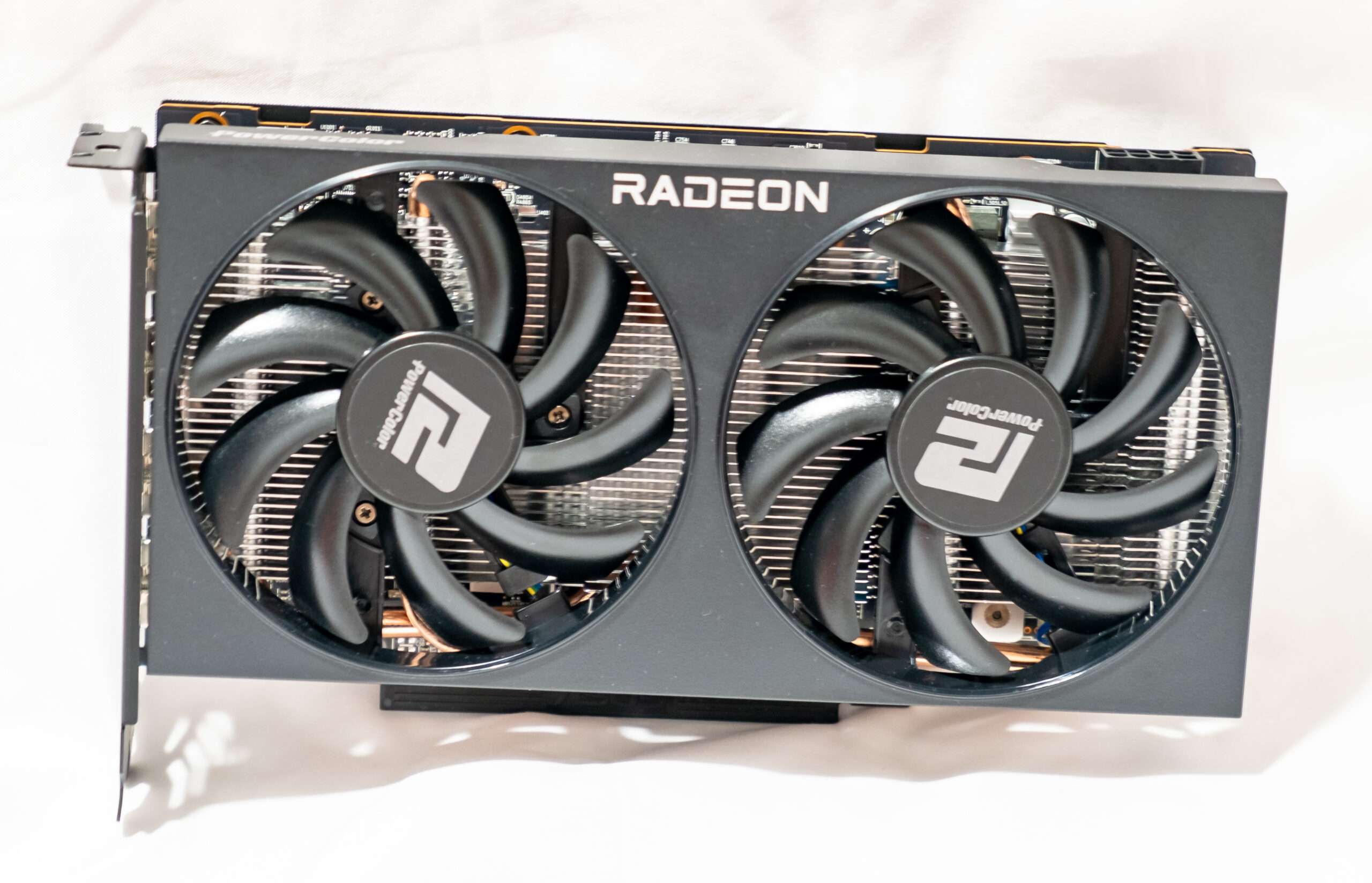
| PowerColor Radeon RX 7600 Fighter Graphics Specifications | |
|---|---|
| Core Clock [Game/Boost] | 2250/2655 MHz |
| Number of universal processors | 2048 |
| Number of texture blocks | 128 |
| Number of blending blocks | 64 |
| Effective memory frequency | 18 GHz |
| Memory type | GDDR6 |
| Memory bus | 128 bit |
| Memory | 8 GB |
| Memory Bandwidth | 288 GB/s |
| Computing performance (FP32) | up to 21.8 teraflops |
| Theoretical maximum fill rate | 170 gigapixels/s |
| Theoretical texture sampling rate | 340 Gtexels/s |
| Tire | PCI Express 4.0 x8 |
| Connectors | one HDMI 2.1b, three DisplayPort 2.1 |
| Energy consumption | up to 165 W |
| Extra food | one 8-pin connector |
| Number of slots occupied in the system chassis | 2 |
| Recommended price | $419 – 3 Years warranty |
The card has a single 8-pin PCIe auxiliary power connector that has a maximum output of 150W in addition to the 75W PCIe slot.
Interestingly, by the way, the power consumption level for the RX 7600 is set to 165 watts, while the RX 6600 from the previous generation had 132 watts, and the RX 6600 XT almost the same 160 watts.
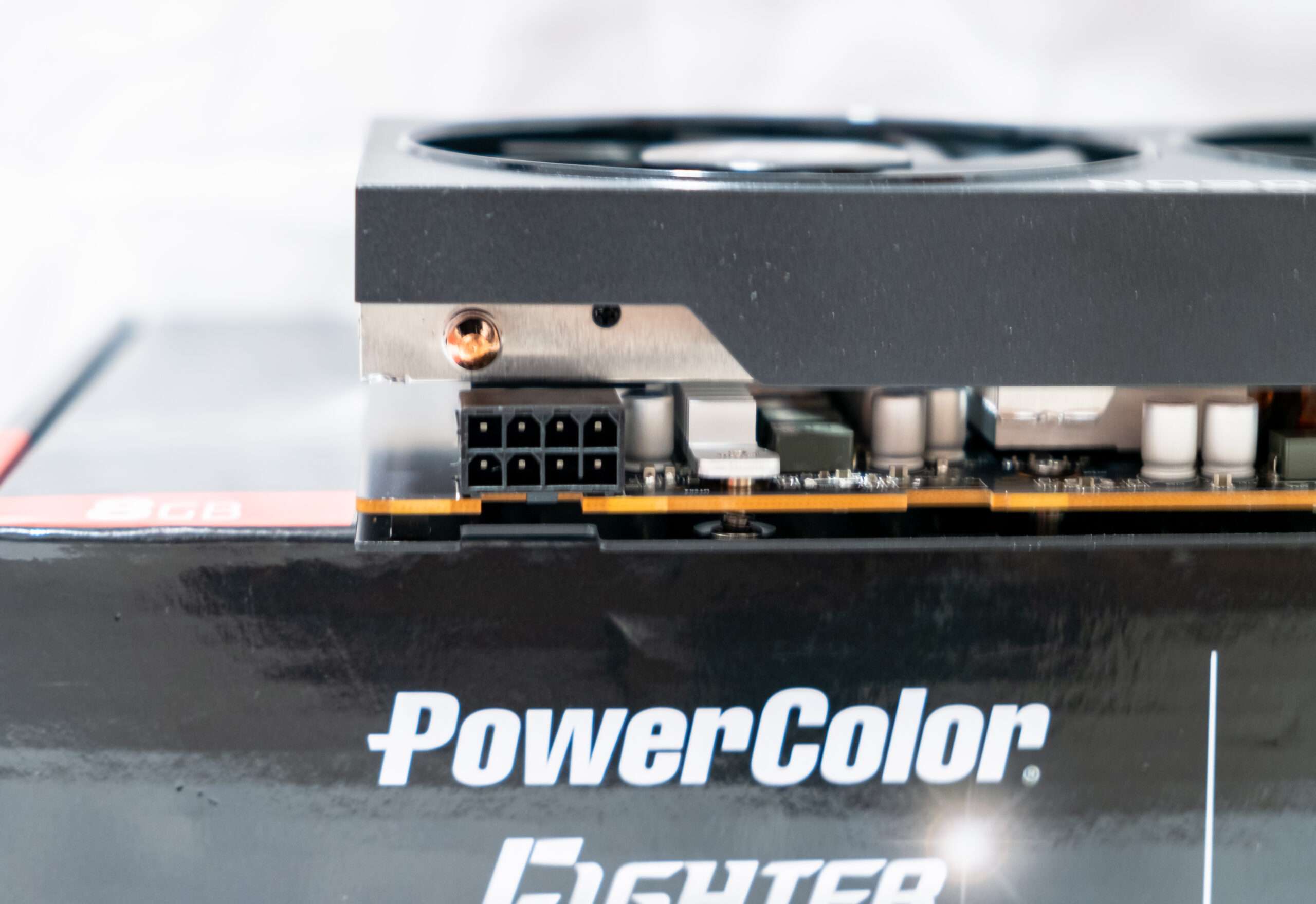
The Powercolor uses direct 4 copper heatpipes contact the GPU die to enhance heat dissipation efficiency.
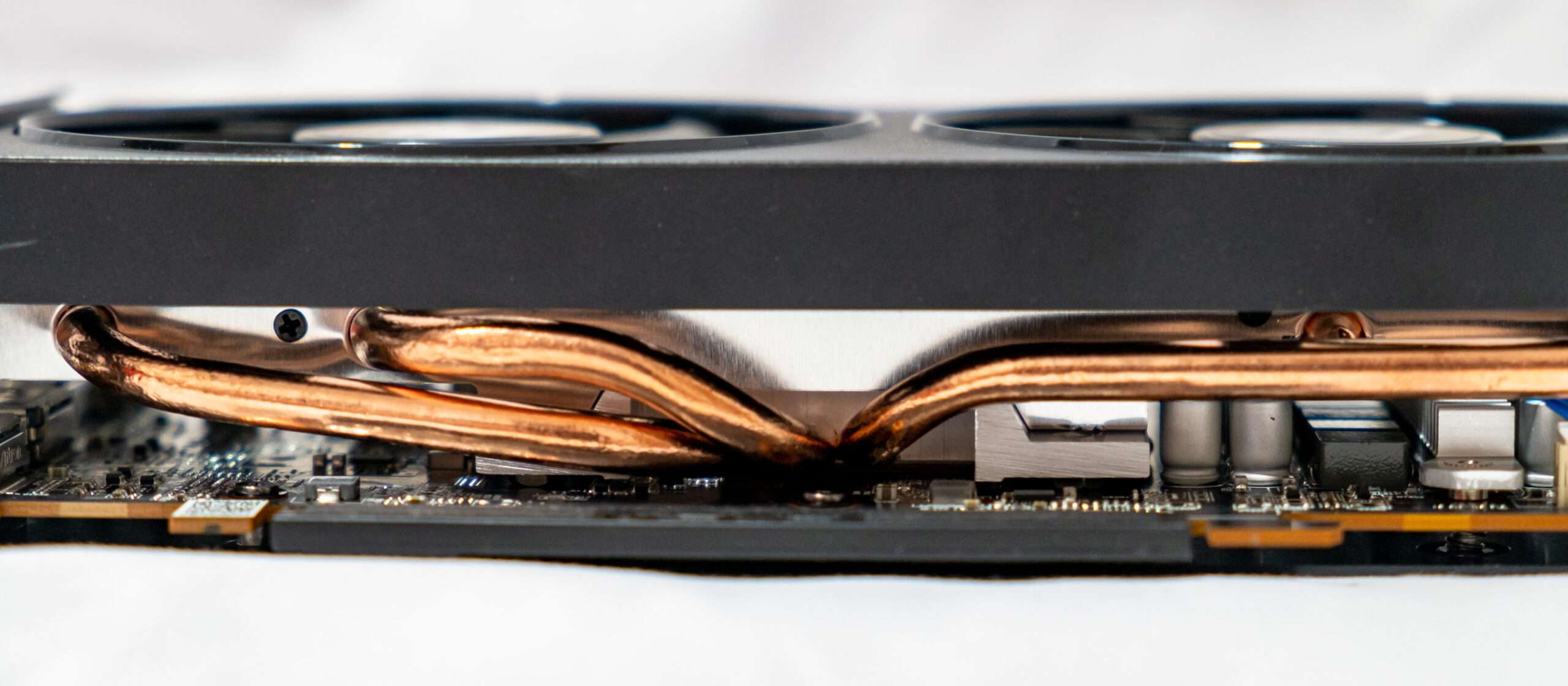
PowerColor RX7600 Fighter graphics card has three DisplayPort 2.1 UHBR13.5 (54 Gb/s) connectors and one HDMI 2.1 (48 Gb/s) connector – here it has a clear advantage over similar Nvidia solutions, which are still limited by DisplayPort 1.4a capabilities. So if you need to output 4K at 240Hz without streaming over a single cable, you can do it even on a budget AMD graphics card. But you’ll need a DisplayPort 2.1 monitor or TV, and at that cost, they’re unlikely to pair with RX 7600-based systems.
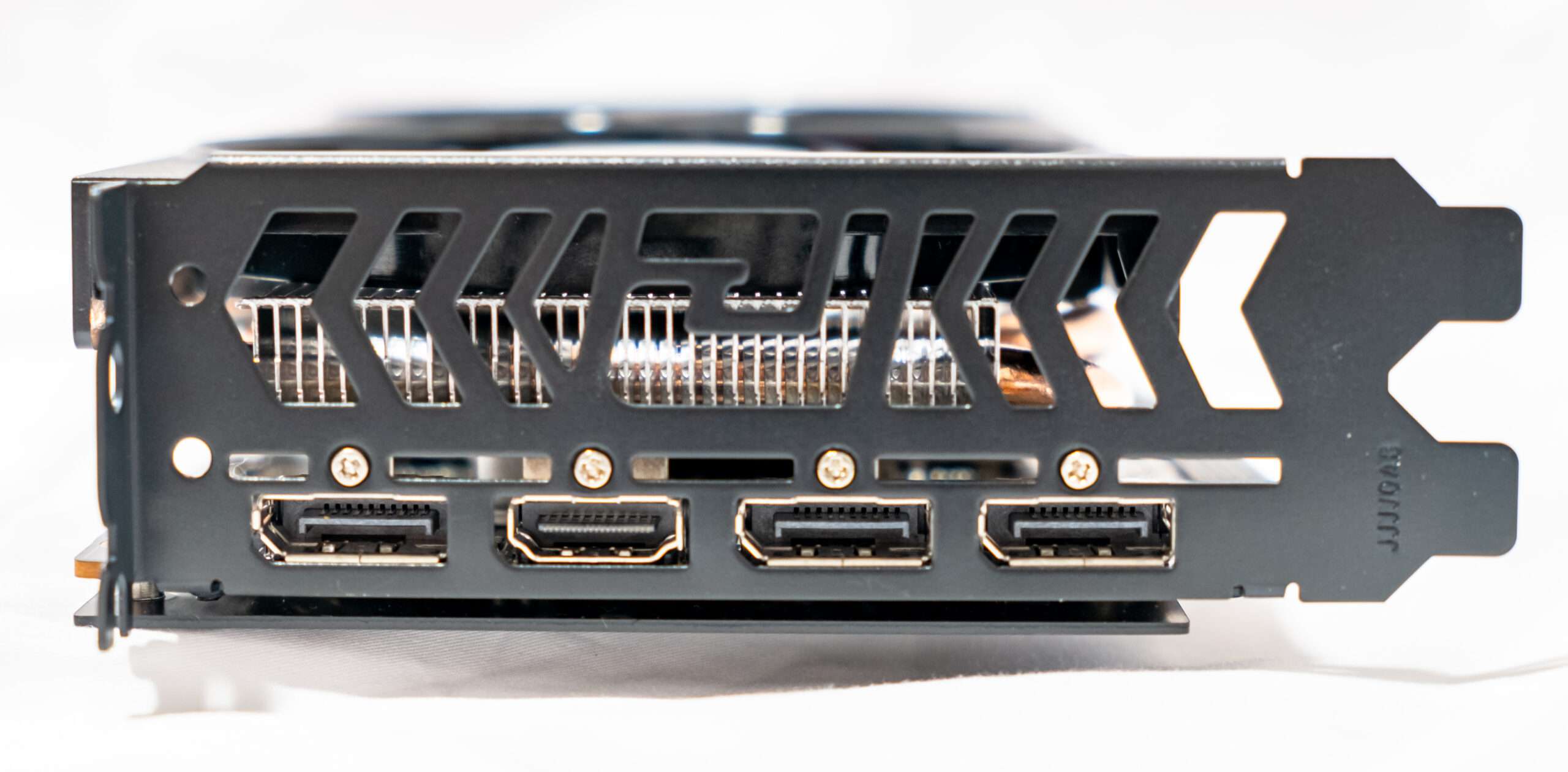
Therefore, the Radeon RX 7600 graphics card is based on the Navi 33 monolithic GPU, which was manufactured using a 6 nm process technology. This medium-sized die is a low-end implementation of RDNA3, contains 13.3 billion transistors and has an area of about 204 mm². Like the RX 6600 XT, the RX 7600 has the same number of execution units, a relatively small 32MB Infinity Cache, a 128-bit memory bus, and only eight PCIe lanes. Such savings are understandable for budget solutions, but compared to older chips, the RX 7600 also worsened the process technology – 6nm does not provide the performance and power consumption characteristics that 5nm would give, and in fact in previous generations all models of a single series used the same process.
By the way, TSMC’s 6nm process technology is also used for the production of I/O chiplets in Zen 4 processors and for chips with memory controllers in older Navi 31 GPUs. That is, where they obviously saved money and it made sense. It seems that this generation of GPUs has seen the cost of manufacturing on advanced manufacturing processes rise too much, resulting in both higher prices and less performance gains in budget solutions compared to previous generations.
The power efficiency of the RX 7600 has also not improved compared to the RX 6600 (XT), which is not surprising, since TSMC’s 6nm process does not provide a performance boost or power consumption reduction compared to 7nm, but simply provides a slightly higher transistor density. Once again, the budget die has an area of 204 mm² and the number of transistors is about 13.3 billion – compare this with the AD106 (RTX 4060 Ti), consisting of 22.9 billion transistors in a 190 mm² chip, which is manufactured using a 5nm process.
The Powercolor come with black metal back plate
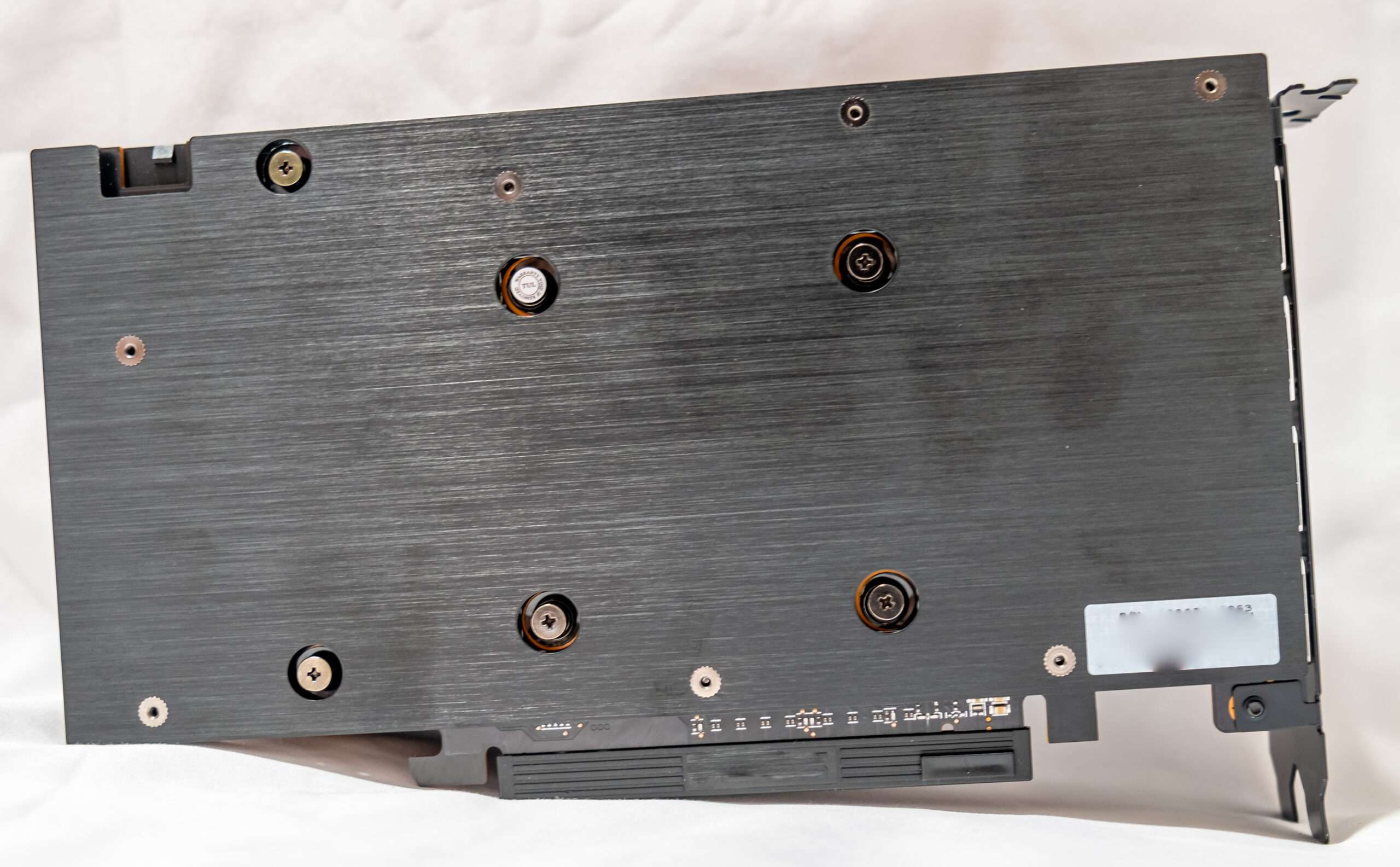
AI acceleration blocks introduced in the RDNA3 architecture remap SIMD32 modules to perform matrix calculations instead of normal FP32/FP16 operations. Supported with FP16 are BF16 and INT8 formats, and all three have the same peak performance of twice the single precision floating point performance of FP32. The performance improvement of matrix calculations, which are often used in artificial intelligence tasks, is estimated by AMD at 2.7 times, taking into account all the improvements. For gaming GPUs, this is potentially important for the likely future use of AI acceleration in FSR 3.0 scaling technology, but we will talk about this more below.
As for the hardware changes in the junior RDNA3 solution, first of all, we can note a smaller register file size – the RX 7600 has a register file of 128 KB per SIMD compared to 192 KB for the RX 7900. In total, Navi has 33 8 MB vector registers, and Navi 31 has 36.8 MB. This can potentially result in reduced performance on a large number of compute and graphics tasks, but rasterization shouldn’t be much of a problem, as pixel shaders usually don’t use too many vector registers.
Another change in Navi 33 was, although the reduced size of the Infinity Cache cache, but the reduction in access delays to it, and at the same time to the video memory – the RX 7600 shows a noticeable improvement in these parameters compared to the flagship RX 7900 video cards – about one and a half times. This is due to the low-end GPU’s monolithic design compared to the Navi 31’s chiplet design – logically, on-chip links are much faster than on-chip links.
Unlike higher-end graphics cards, the RX 7600 only supports eight PCIe 4.0 lanes, so peak interface bandwidth will be half as much, but that should be enough for this GPU segment. And they cut them down, among other things, because a smaller number of PCIe lanes saves chip area, since I / O interfaces do not shrink very well when transferring crystals to more advanced technical processes. The same applies to video memory channels, by the way – that is why manufacturers are trying to switch to ever narrower buses in inexpensive and small chips.
But since the solutions support PCIe 4.0, the bandwidth of the RX 7600 will be quite enough – on par with solutions of previous generations using 3.0 x16, and definitely better than older GPUs like the Radeon RX 460, which uses only 3.0 x8. But this only applies to relatively new gaming systems that support PCIe 4.0 – processor and / or chipset, and users have older systems on their hands without such support – and AMD offers the RX 7600 specifically for an upgrade.
It remains to be noted that compared to the previous generation of video cards, the Radeon RX 7000 has significantly improved the subsystem for displaying information on displays. All hardware capabilities for encoding and decoding video formats in Navi 33 do not differ from older solutions, including support for AV1 and SmartAccess Video – the ability to use the hardware encoder of the built-in video core in Ryzen 7000 processors in desktop PCs.
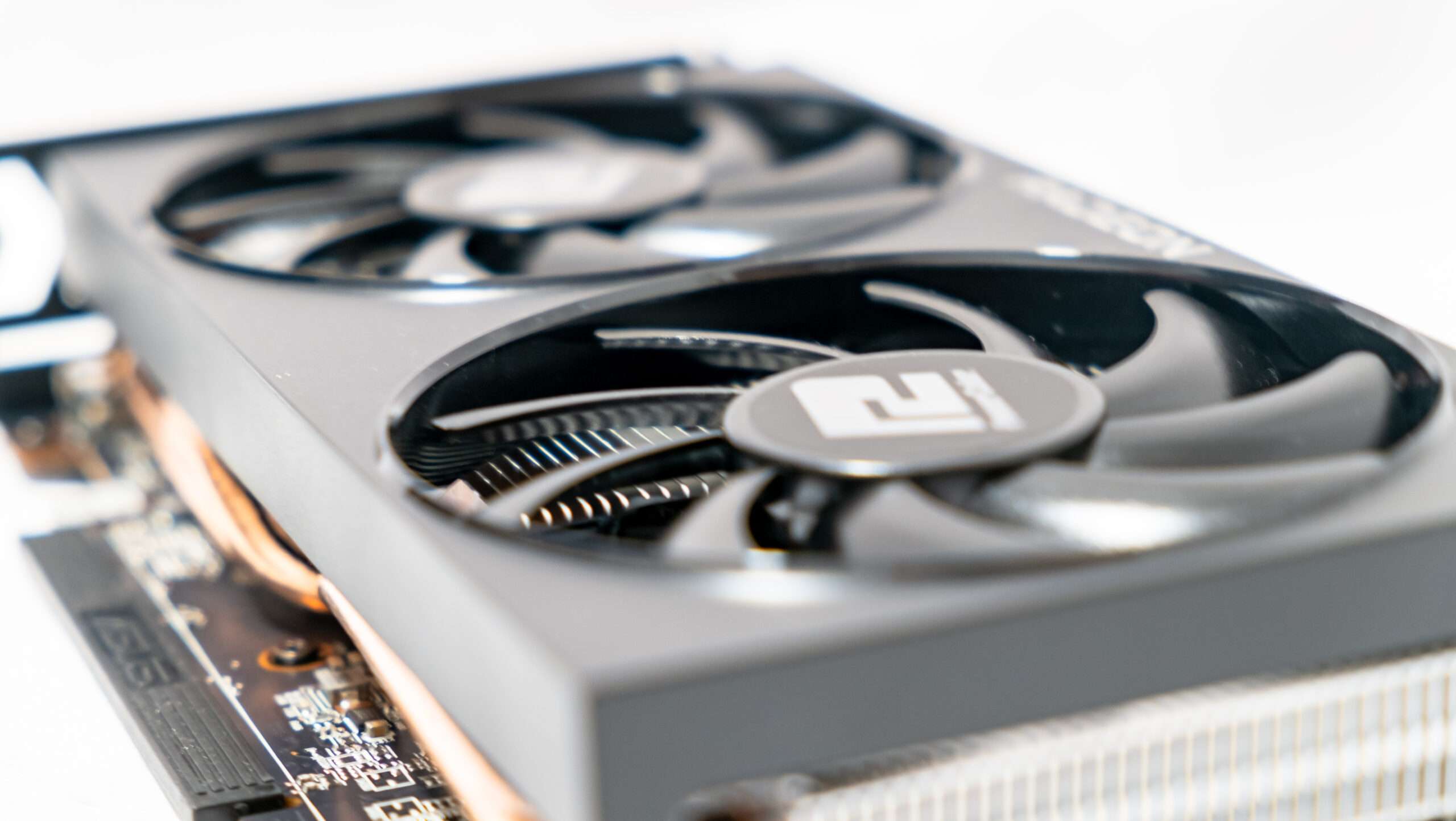
The PowerColor RX7600 Fighter is capable of encoding and decoding AV1 video at 8K resolution at 60 FPS. And the new Radiance Display Engine supports DisplayPort 2.1 connectors at UHBR 10 and UHBR 13.5 data rates, twice those of DisplayPort 1.4. Although Intel graphics cards also have DisplayPort 2.1 support, the maximum bandwidth for Arc solutions is limited to 40 Gb / s (UHBR 10), and for the Radeon RX 7600 it is already 54 Gb / s (UHBR 13.5). Supporting this bandwidth means you can connect a 4K display with a single cable – with refresh rates up to 240 Hz without the use of video stream compression, and with Display Stream Compression, you can use 4K at 480 Hz or 8K at 165 Hz.
Benchmark:
PowerColor RX7600 Fighter is the budget range graphics card in AMD RDNA 3 Navi 33-based segment. As such, our graphics workstation, based on an AsRock Z790PG-ITX/TB4 motherboard and Intel 13900k 24 cores processor. The ram we will be using is XPG 6000mhz- 32Gb memory kit. ADATA XPG GAMMIX S50 Lite 1TB M.2 NVMe SSD is used as well to run with benchmark. On the Comparison, we will be testing 3 GPUs to run side by side to see perform better.
| Model | DIY System |
| Motherboard | AsRock Z790PG-ITX/TB4 |
| CPU | Intel Core i9 13900K – 24 Cores/32 Threads |
| Cooling | Arctic Liquid Freezer II 280 A-RGB |
| Ram | XPG DDR5 6000Mhz |
| SSD | ADATA XPG GAMMIX S50 Lite 1TB M.2 NVMe |
| OS | Microsoft Windows 11 Pro 22H2 |
| Bios | 6.04 |
| Model | Graphic Engine | Bus Standard | Video Memory | GPU Clock | Boost GPU Clock | Memory Clock | Resizeable Bar | Driver |
| ASUS TUF RTX 4070Ti OC 12GB GDDR6X | RTX4070 AD104 | PCI Express 4.0 | 12GB GDDR6X | 2730 | 2760 | 1313 | Enable | 531.79 |
| ASUS GeForce RTX 4060TI 8GB GDDR6 | RTX4060Ti AD106 | PCI Express 4.0 | 8GB GDDR6 | 2625 | 2655 | 2250 | Enable | 535.98 |
| PowerColor RX7600 Fighter | Navi 33 | PCI Express 4.0 | 8GB GDDR6 | 2250 | 2655 | 2250 | Enable | 23.5.1 |
GPUZ

3Dmark Advanced Edition
3DMark includes everything you need to benchmark your PC and mobile devices in one app. Whether you’re gaming on a smartphone, tablet, notebook, or a desktop gaming PC, 3DMark includes a benchmark designed specifically for your hardware.
| 3DMark Advanced Edition | ||||||
| Model | Speed Way | Fire Strike Ultra | Night Raid | Port Royal | Time Spy Extreme | Wild Life Extreme |
| ASUS TUF RT4070Ti | 5417 | 13799 | 94007 | 14135 | 11299 | 46166 |
| ASUS TUF RT4060Ti | 3169 | 7574 | 86421 | 8104 | 6756 | 25589 |
| PowerColor RX7600 | 1929 | 7219 | 76735 | 5399 | 5580 | 18159 |
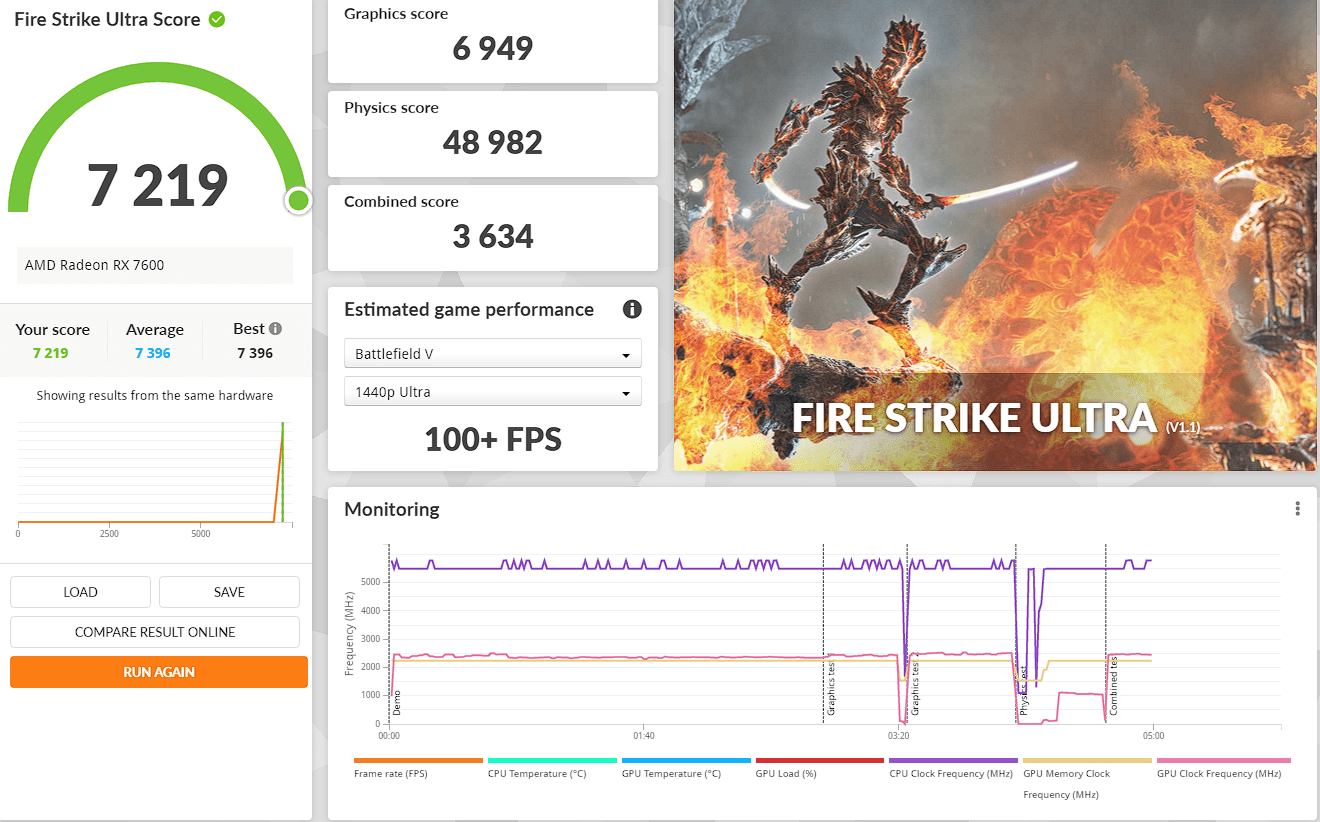
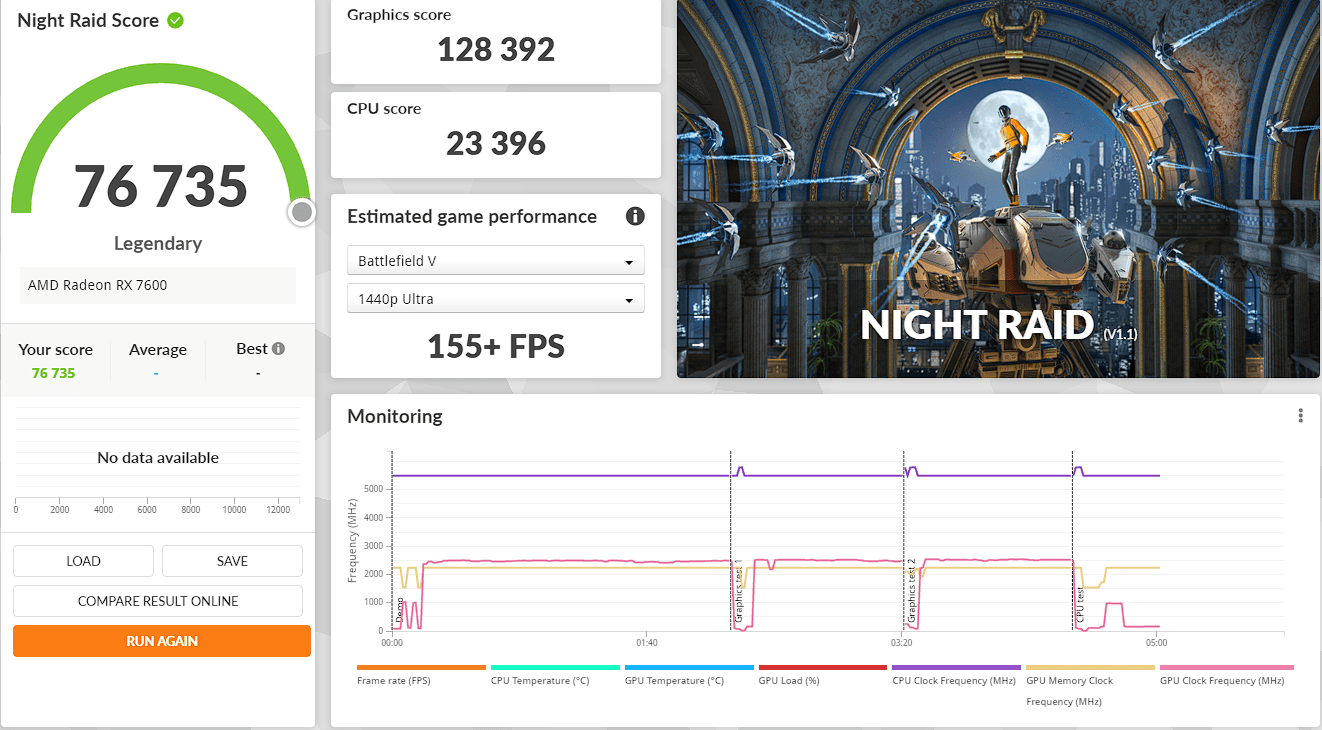

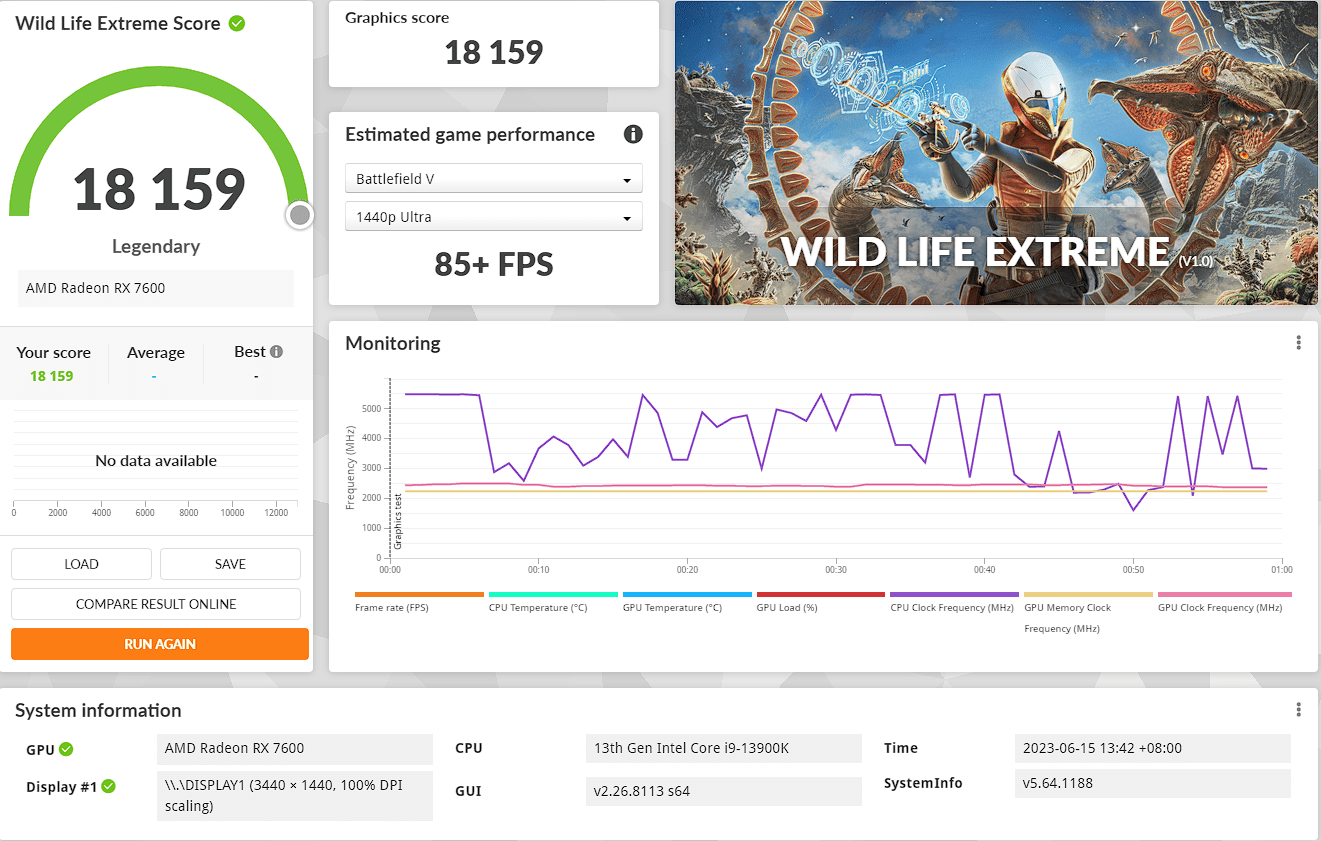
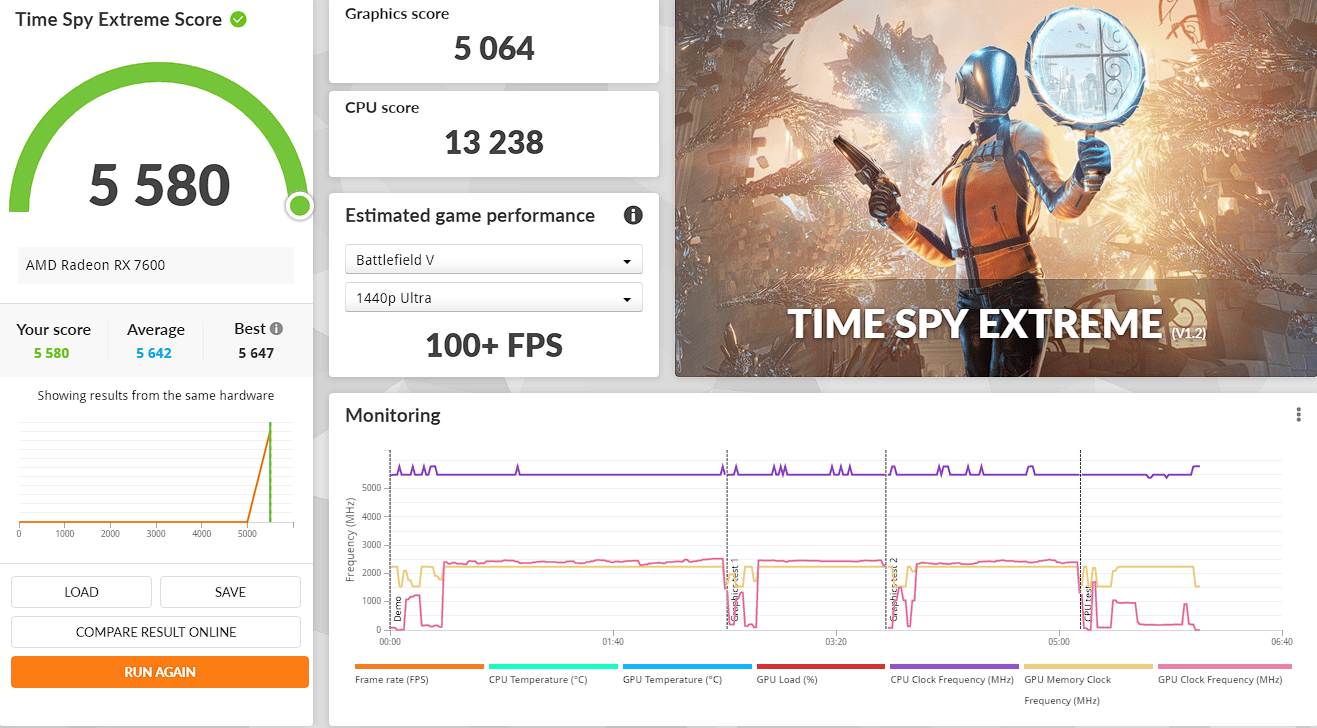
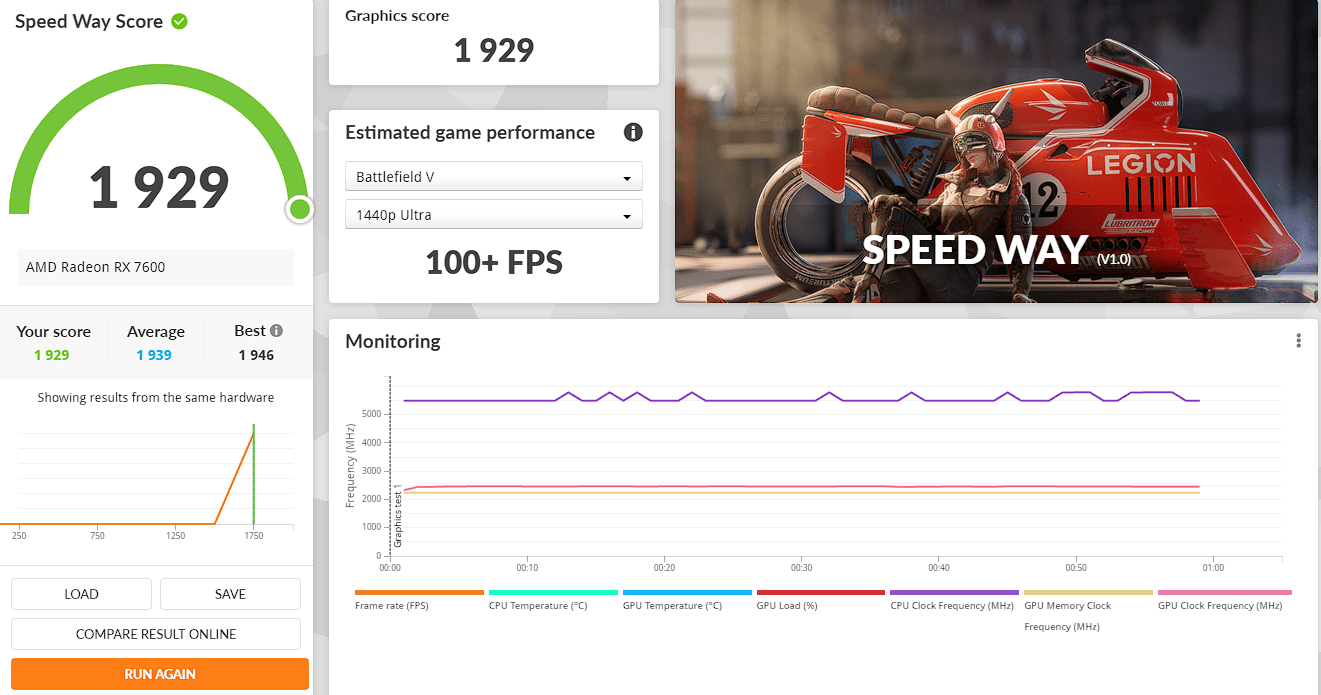
Ashes of the Singularity Escalation
As a real-time strategy title, Ashes is all about responsiveness during both wide open shots but also concentrated battles. With DirectX12 at the helm, the ability to implement more draw calls per second allows the engine to work with substantial unit depth and effects that other RTS titles had to rely on combined draw calls to achieve, making some combined unit structures ultimately very rigid.
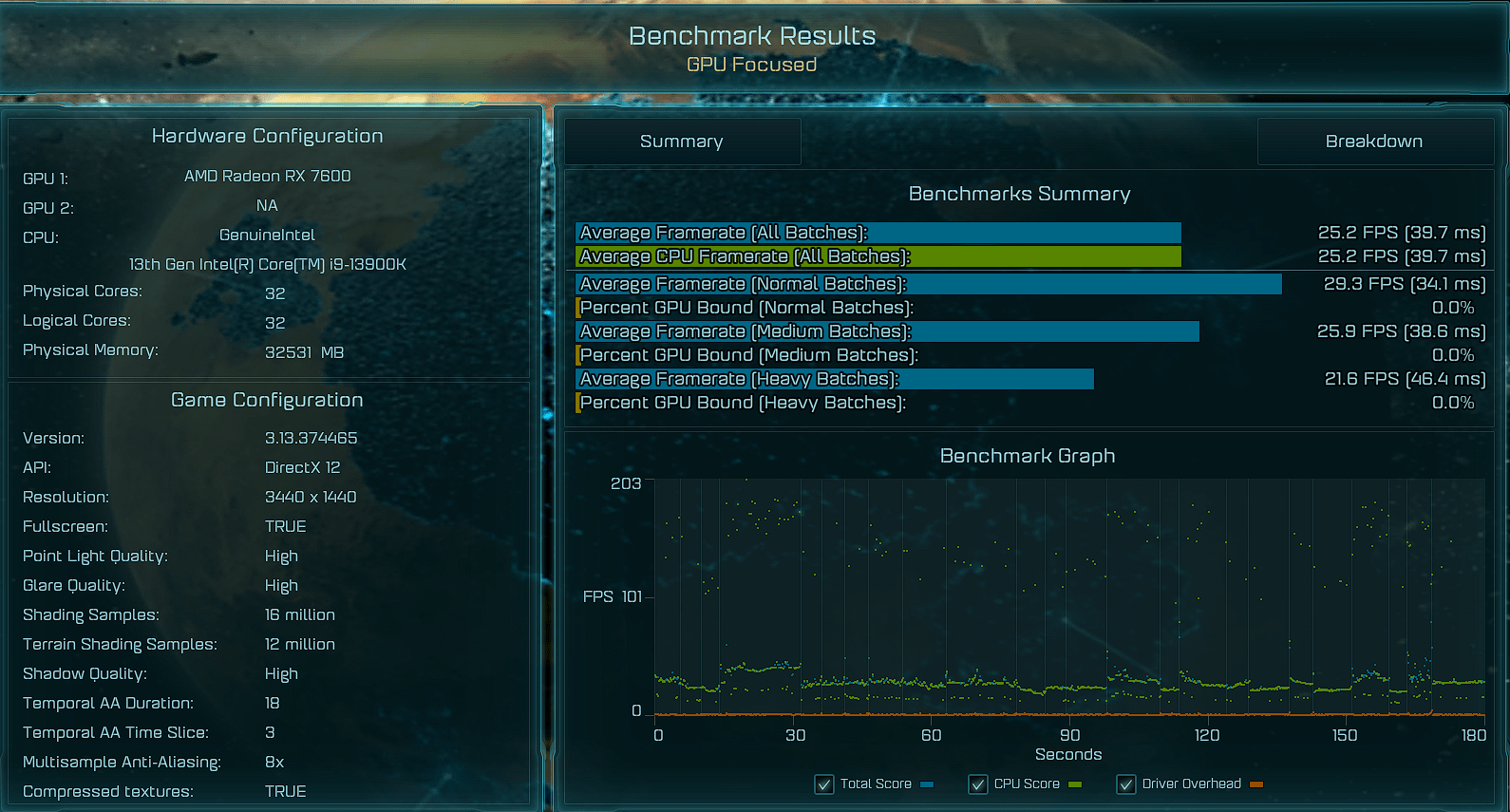
BaseMark GPU
Basemark GPU is a professional evaluation tool to evaluate and compare graphics performance across mobile and desktop platforms. Uniquely, it supports all major graphics APIs and operating systems.
| BaseMark GPU | ||||
| Model | Average | Minimum | Maximum | Overall Score |
| ASUS TUF RT4070Ti | 221 | 183 | 334 | 22146 |
| ASUS TUF RT4060Ti | 124 | 104 | 197 | 12429 |
| PowerColor RX7600 | 87 | 26 | 1377 | 8741 |
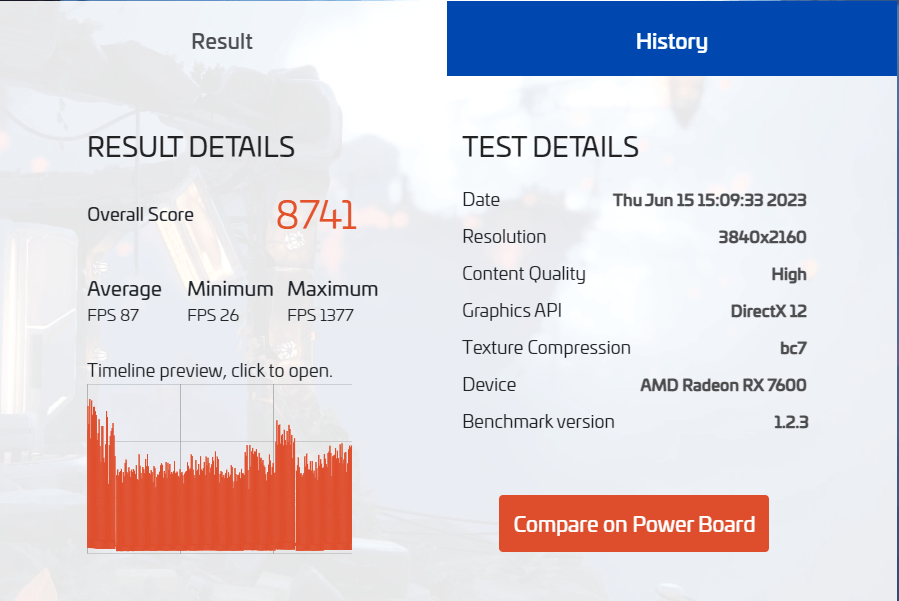
Heaven Benchmark
Extreme performance and stability test for PC hardware: video card, power supply, cooling system. Check your rig in stock and overclocking modes with real-life load! Also includes interactive experience in a beautiful, detailed environment.
| Heaven Benchmark | ||||
| Model | FPS | Minimum FPS | Maximum FPS | Score |
| ASUS TUF RT4070Ti | 311.3 | 11 | 678.9 | 7841 |
| ASUS TUF RT4060Ti | 175.8 | 44.9 | 410.5 | 4428 |
| PowerColor RX7600 | 136.3 | 44.6 | 309.6 | 3432 |
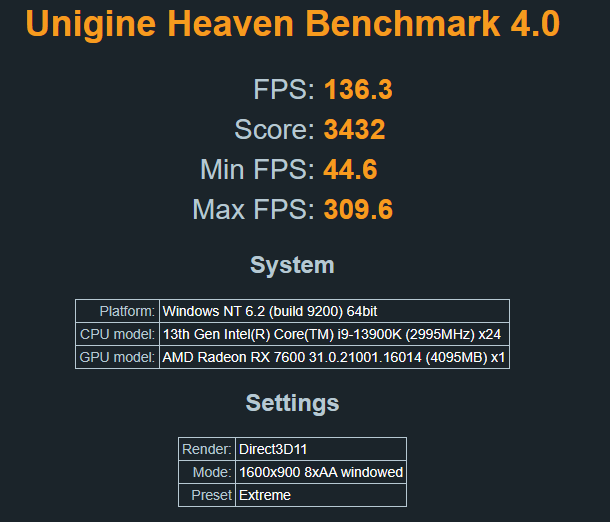
SuperPosition
Extreme performance and stability test for PC hardware: video card, power supply, cooling system. Check your rig in stock and overclocking modes with real-life load! Also includes interactive experience in a beautiful, detailed environment.
| SuperPosition Benchmark | ||||
| Model | Average | Minimum | Maximum | Score |
| ASUS TUF RT4070Ti | 129.48 | 108.04 | 159.49 | 17311 |
| ASUS TUF RT4060Ti | 72.8 | 60.75 | 89.36 | 9732 |
| PowerColor RX7600 | 56.11 | 48.58 | 67.53 | 7502 |
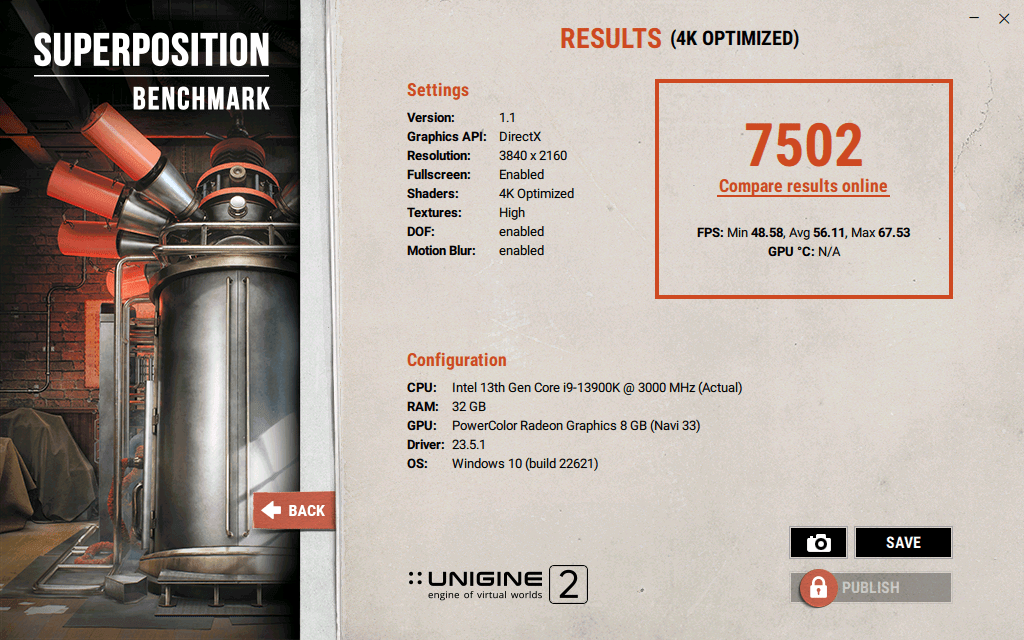
Batman Arkham Origins
Taking place before the rise of Gotham City’s most dangerous criminals, the game showcases a young and unrefined Batman as he faces a defining moment in his early career as a crime fighter that sets his path to becoming the Dark Knight.
| Batman Arkham Origins | |||
| Model | Average | Minimum | Maximum |
| ASUS TUF RT4070Ti | 124 | 102 | 151 |
| ASUS TUF RT4060Ti | 214 | 121 | 371 |
| PowerColor RX7600 | 123 | 104 | 147 |
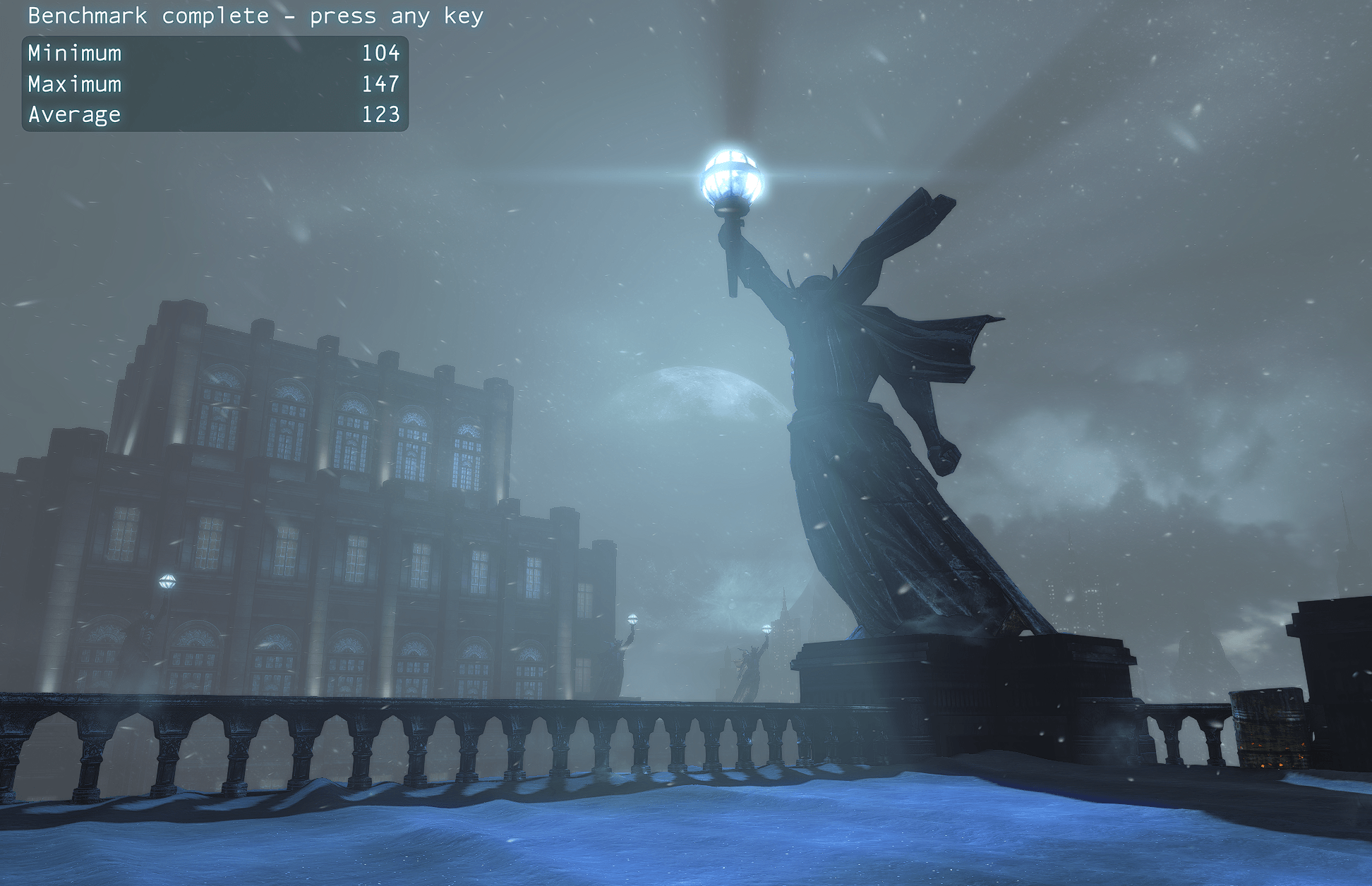
FarCry 6
Far Cry 6 supports ray tracing at launch, with the ability to enable DXR reflections and DXR shadows. But because DXR shadows are kind of pointless and not worth the performance hit, we haven’t tested with them enabled, but I have taken a look at DXR reflections, so we’ll look at that shortly using supported hardware.
| FarCry 6 | |||
| Model | Average | Minimum | Maximum |
| ASUS TUF RT4070Ti | 114 | 85 | 130 |
| ASUS TUF RT4060Ti | 61 | 24 | 71 |
| PowerColor RX7600 | 44 | 15 | 58 |

Sleeping Dog
In this open world game, you play the role of Wei Shen, an undercover cop trying to take down the Triads from the inside out. You’ll have to prove yourself worthy as you fight your way up the organization, taking part in brutal criminal activities without blowing your cover.
Torn between your loyalty to the badge and a criminal code of honor, you will risk everything as the lines between truth, loyalty and justice become permanently blurred.
| Sleeping Dog | |||
| Model | Average | Minimum FPS | Maximum FPS |
| ASUS TUF RT4070Ti | 131.8 | 72 | 189.1 |
| ASUS TUF RT4060Ti | 90.9 | 51.8 | 180.8 |
| PowerColor RX7600 | 62.9 | 40.6 | 83.6 |
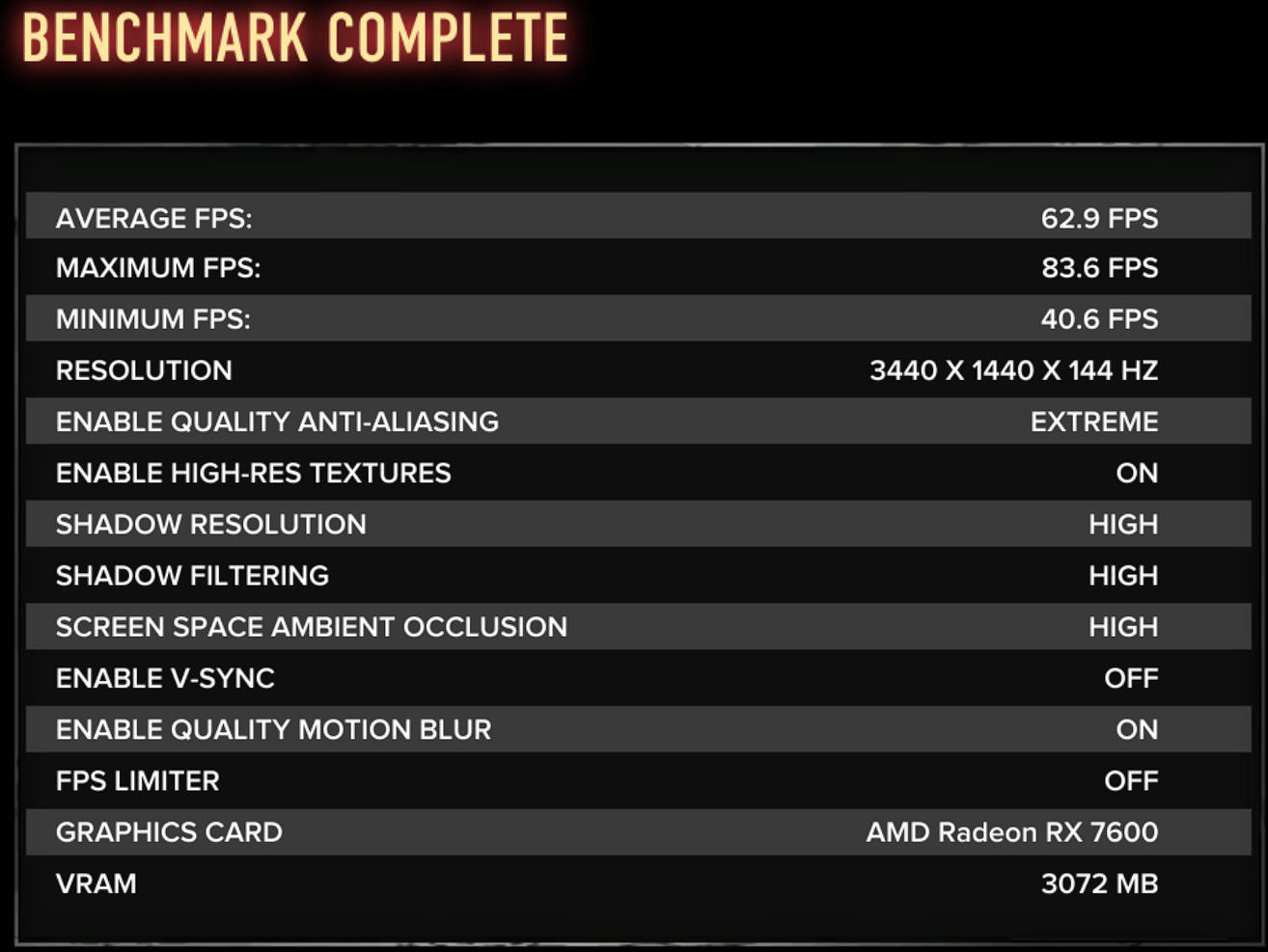
Ghost Recon Breakpoint
Ghost Recon Breakpoint is a military shooter set in a diverse, hostile, and mysterious open world that you can play entirely solo or in four-player co-op.
| Ghost Recon Breakpoint | |||
| Model | Total Score | Frames Score | FPS |
| ASUS TUF RT4070Ti | S | 2251 | 130 |
| ASUS TUF RT4060Ti | A | 15165 | 88 |
| PowerColor RX760 | A | 15499 | 90 |
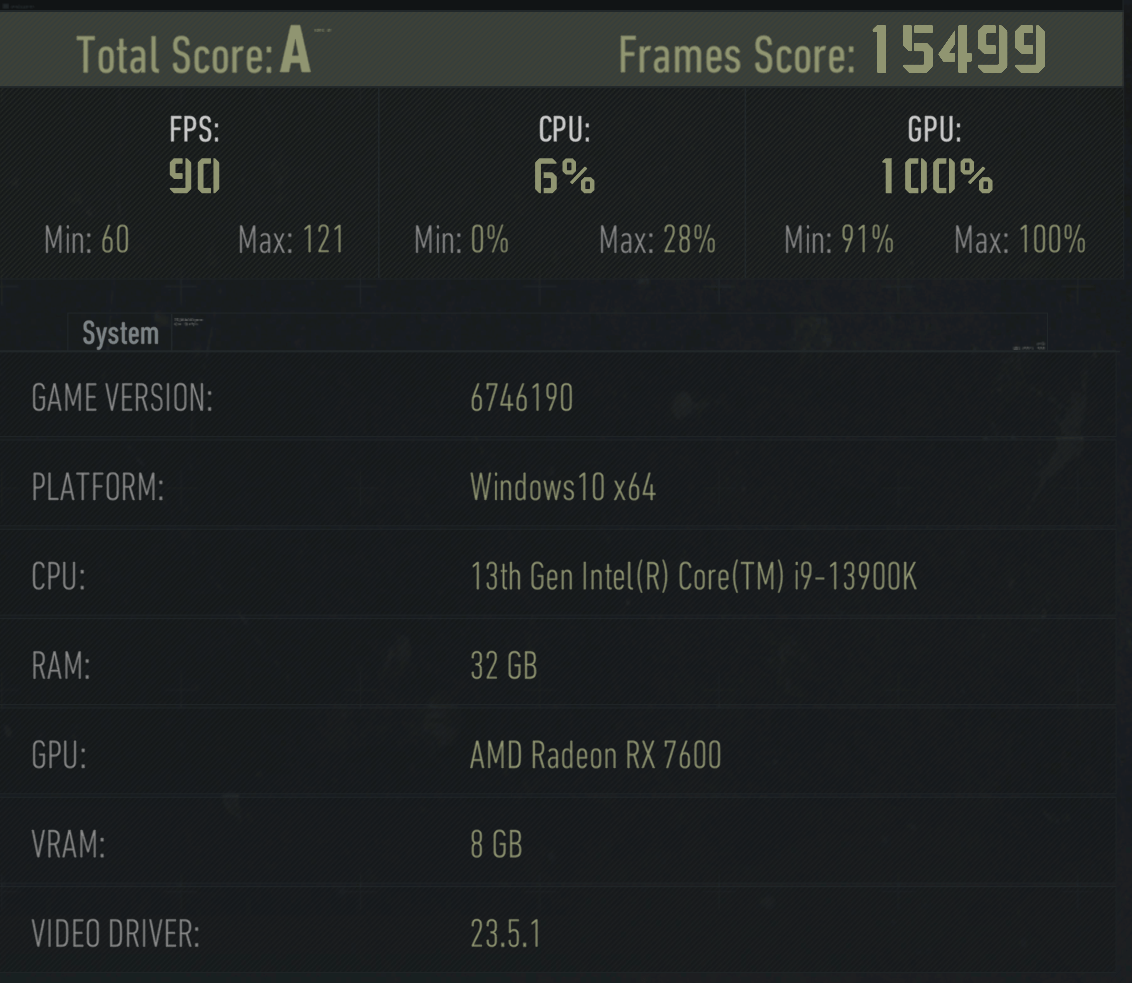
Total War WARHAMMER
Addictive turn-based empire-building with colossal, real-time battles, all set in a world of legendary heroes, giant monsters, flying creatures and storms of magical power.
| Total War WARHAMMER | |||
| Model | Average | Minimum FPS | Maximum FPS |
| ASUS TUF RT4070Ti | 48.3 | 33 | 64 |
| ASUS TUF RT4060Ti | 29 | 19 | 38 |
| PowerColor RX7600 | 15.7 | 12 | 19 |
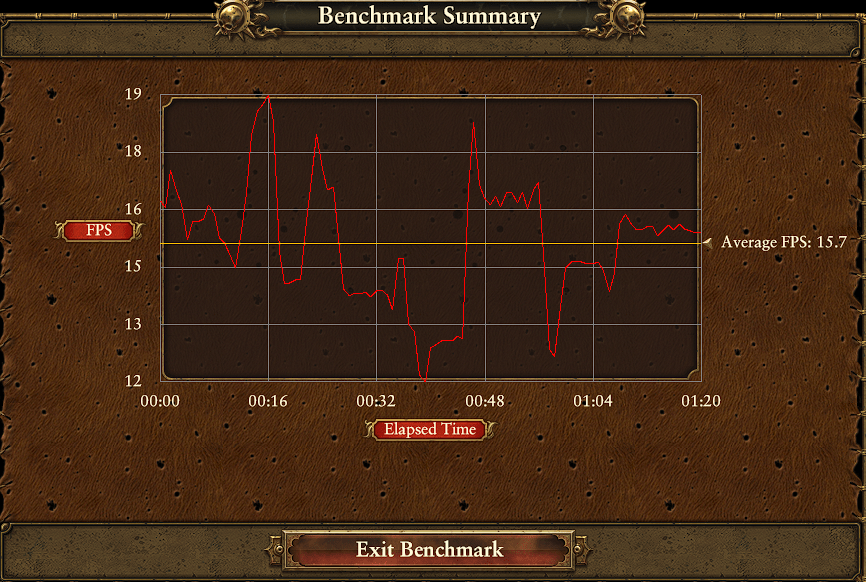

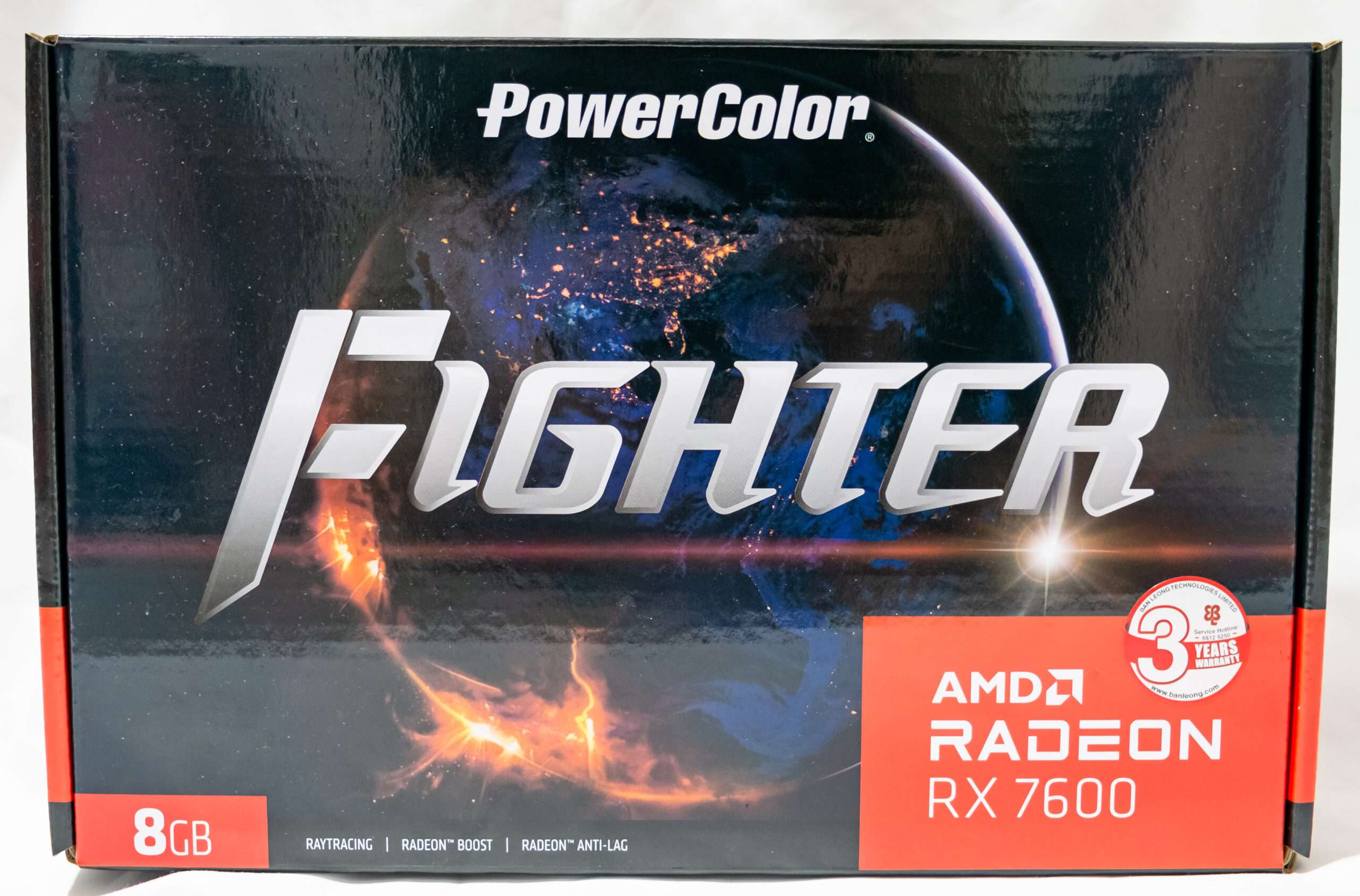
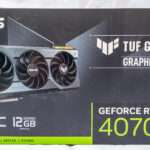
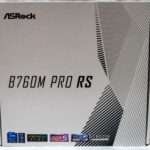


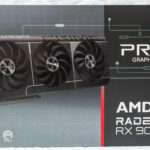
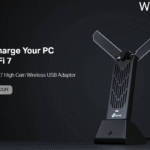

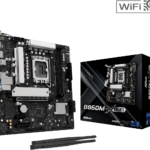

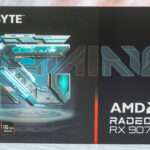
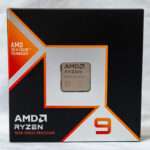
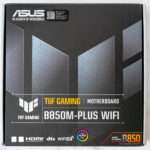

may I know the fans speeds at load?
Dear Mark,
The fan wasn’t loud during full load.